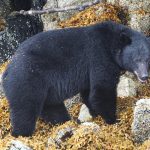 According to Cornell Chronicle, the black bear population in southern New York has grown and expanded their range since the early 1990s. New Cornell research shows average density of black bears in the southern New York area was about 13 bears per 38.6 square miles or about one bear for every 3 square miles. Bear densities have decreased slightly farther north in the study region, supporting the idea that black bear ranges have been expanding northward.
According to Cornell Chronicle, the black bear population in southern New York has grown and expanded their range since the early 1990s. New Cornell research shows average density of black bears in the southern New York area was about 13 bears per 38.6 square miles or about one bear for every 3 square miles. Bear densities have decreased slightly farther north in the study region, supporting the idea that black bear ranges have been expanding northward.
New York has three historic bear ranges: the Adirondack, Catskill and Allegheny mountain regions. But the Catskill and Allegheny ranges have expanded and now are jointly considered a single range that covers the entire Southern Tier region of New York.
Black Bear Facts
- Black bears are large – They have erect, rounded ears; a long, narrow, brown muzzle; and a short tail. An average adult male weighs about 300 pounds while females average about 170 pounds. In New York State, black bears (Ursus americanus) are the second largest mammal (the moose is the largest).
- A little over half of the state’s black bear population is located right in the Adirondack Park. Although black bears are considered dangerous, they are actually one of the most elusive animals in the region and tend to avoid human contact.
- Black bears can remain dormant for up to 5 months in winter.
- Bears eat nearly anything – They are omnivorous; eating grasses, berries, fruit, nuts, seeds, insects, grubs, and carrion, as well as human sources of food like corn, honey, bird seed, trash, and pet food when available.
- Bears are curious – They spend a great deal of time exploring for food, and this can bring them close to humans.
- Bears are intelligent – Bears learn from experience. If an activity results in food, they will repeat that activity. If an encounter with a human is negative, they learn to avoid humans. Also if an encounter with a human doesn’t result in a reward (food), they will not have any reason to have contact with humans.
- Feeding bears creates human-bear conflicts – When bears learn to obtain food from humans, they can become bold and aggressive. Deliberate and intentional feeding of bears is illegal in New York.
- Feeding bears is bad for bears – Bears’ natural foraging habits and behavior can be changed. Usually solitary, bears can be concentrated in areas causing stress, injuries from physical conflicts, and the spread of diseases. Often when feeding on garbage or camper’s supplies, bears will eat unhealthy materials such as soap, shaving cream, insect repellant, food packaging, etc.
Websites
- Black bears on the move in upstate New York
- Your Guide to the Adirondack Region
- Catskill Mountaineer
Videos
- Living with Black Bears in NY State
- What to Do If You See a Black Bear [Adirondacks]
- Morning everyone! Join us as wildlife technician, Emily …
